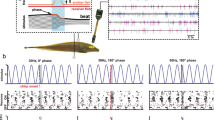Abstract
Objective
The passive electrosense is a primitive sensory modality in the Chondrostei, which include sturgeon and paddlefish. Using electroreceptors, these fish detect the weak electric fields from other animals or geoelectric sources, and use this information for prey detection or other behaviors. The primary afferent fibers innervating the electroreceptors project to a single hindbrain target called the dorsal octavolateral nucleus (DON), where the electrosensory information is first processed. Here, we investigated the electrophysiological properties of DON neurons.
Methods
Extracellular recording was used to investigate the response properties of DON neurons to dipole electric fields with different amplitudes and frequencies in the white sturgeon, Acipenser transmontanus.
Results
The DON neurons showed regular spontaneous activity and could be classified into two types: neurons with a low spontaneous rate (<10 Hz) and those with a high spontaneous rate (>10 Hz). In response to sinusoidal electric field stimuli, DON neurons showed sinusoidally-modulated and phase-locked firing. In addition, neurons showed opposite phase responses corresponding to the different directions of the dipole.
Conclusion
The response properties of DON neurons match the electrosensory biological function in sturgeon, as they match the characteristics of the electric fields of its prey.
摘要
目的
软骨硬鳞鱼类的电感受是一种古老的感觉系统, 它们通过电感受器官感受生物电场或非生物电场进行摄食等活动。支配电感受器的初级传入神经首先将电感受信息传递至后脑的背听侧核进行处理。本文探讨了鲟鱼背听侧核的电生理特性。
方法
采用胞外记录方法记录了高首鲟背听侧核在偶极子电场刺激下的神经元反应。
结果
背听侧核神经元有低频(<10 Hz)自发放电和高频(>10 Hz)自发放电两种, 在电场刺激下均产生明显的自发放电的调制和相位耦合反应, 同时部分神经元对偶极子电场的方向有选择性。
结论
鲟鱼的电感受神经元反应特征与其电感受的生物功能相适应。
Similar content being viewed by others
References
Bodznick D, Montgomery JC. The physiology of low-frequency electrosensory systems. In: Bullock TH, Hopkins CD, Popper AN, Fay RR (Eds.). Electroreception. New York: Springer, 2005: 132–153.
Wilkens LA, Hofmann MH. Behavior of animals with passive, lowfrequency electrosensory systems. In: Bullock TH, Hopkins CD, Popper AN, Fay RR (Eds.). Electroreception. New York: Springer, 2005: 229–263.
Bullock TH, Bodznick DA, Northcutt RG. The phylogenetic distribution of electroreception: Evidence for convergent evolution of a primitive vertebrate sense modality. Brain Res Rev 1983, 6(1): 25–46.
Zupanc GKH, Bullock TH. From electrogenesis to electroreception: An overview. In: Bullock TH, Hopkins CD, Popper AN, Fay RR (Eds.). Electroreception. New York: Springer, 2005: 5–46.
Wilkens LA, Hofmann MH. The paddlefish rostrum as an electrosensory organ: A novel adaptation for plankton feeding. BioScience 2007, 57(5): 399–407.
Jørgensen JM. The morphology of the Lorenzinian ampullae of the sturgeon Acipenser ruthenus (Pisces: Chondrostei). Acta Zool (Stockh), 1980, 61: 87–92.
Jørgensen JM. Morphology of electroreceptive sensory organs. In: Bullock TH, Hopkins CD, Popper AN, Fay RR (Eds.). Electroreception. New York: Springer, 2005: 47–67.
Hofmann MH, Falk M, Wilkens LA. Electrosensory brain stem neurons compute the time derivative of electric fields in the paddle-fish. Fluct Noise Lett 2004, 4(1): 129–138.
Hofmann M, Chagnaud B, Wilkens L. Edge-detection filter improves spatial resolution in the electrosensory system of the paddle-fish. J Neurophysiol 2009, 102(2): 797–804.
Bell CC, Maler L. Central neuroanatomy of electrosensory systems in fish. In: Bullock TH, Hopkins CD, Popper AN, Fay RR (Eds.). Electroreception. New York: Springer, 2005: 68–111.
Bodznick D, Montgomery J, Tricas T. Electroreception: extracting behaviorally important signals from noise. In: Collin SP, Marshall NJ (Eds.). Sensory Processing in Aquatic Environments, New York: Springer, 2003: 389–403.
New JG. Medullary electrosensory processing in the little skate. I. Response characteristics of neurons in the dorsal octavolateralis nucleus. J Comp Physiol A 1990, 167(2): 285–294.
Chagnaud BP, Wilkens LA, Hofmann MH. Response properties of electrosensory neurons in the lateral mesencephalic nucleus of the paddlefish. J Comp Physiol A 2008, 194(3): 209–220.
Hofmann MH, Chagnaud BP, Wilkens LA. Response properties of electrosensory afferent fibers and secondary brain stem neurons in the paddlefish. J Exp Biol 2005, 208(22): 4213–4222.
Kajikawa Y, Hackett TA. Entropy analysis of neuronal spike train synchrony. J Neurosci Methods 2005, 149(1): 90–93.
McCreery DB. Two types of electroreceptive lateral lemniscal neurons of the lateral line lobe of the catfish Ictalurus nebulosus; connections from the lateral line nerve and steady-state frequency response characteristics. J Comp Physiol A 1977, 113(3): 317–339.
Hofmann MH, Jung SN, Siebenaller U, Preissner M, Chagnaud BP, Wilkens LA. Response properties of electrosensory units in the midbrain tectum of the paddlefish (Polyodon spathula Walbaum). J Exp Biol 2008, 211(5): 773–779.
Miller M. The ecology and functional morphology of feeding of North American sturgeon and paddlefish. In: Lebreton GTO, Beamish FwH, McKinley (Eds.). Sturgeons and Paddlefish of North America. Dordrecht: Kluwer Academic Publisher, 2004: 87–102.
Potts WTW, Hedges AJ. Gill potentials in marine teleosts. J Comp Physiol B 1991, 161(4): 401–405.
Basov B. Behavior of sterlet Acipenser ruthenus and Russian sturgeon A. gueldenstaedtii in low-frequency electric fields. J Ichthyol 1999, 39(9): 782–787.
Peters RC, Bretschneider F. Electric phenomena in the habitat of the catfish Ictalurus nebulosus LeS. J Comp Physiol A 1972, 81(4): 345–362.
Peters RC, van Wessel T, van den Wollenberg BJ, Bretschneider F, Olijslagers AE. The bioelectric field of the catfish Ictalurus nebulosus. J Physiol Paris 2002, 96(5–6): 397–404.
Author information
Authors and Affiliations
Corresponding author
Rights and permissions
About this article
Cite this article
Zhang, X., Herzog, H., Song, J. et al. Response properties of the electrosensory neurons in hindbrain of the white sturgeon, Acipenser transmontanus . Neurosci. Bull. 27, 422–429 (2011). https://doi.org/10.1007/s12264-011-1635-y
Received:
Accepted:
Published:
Issue Date:
DOI: https://doi.org/10.1007/s12264-011-1635-y




